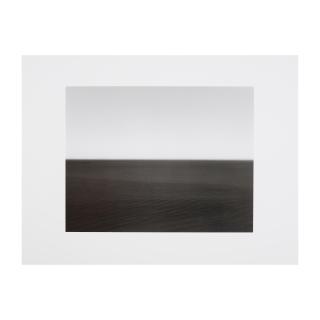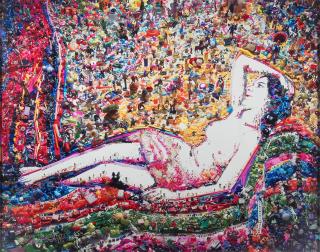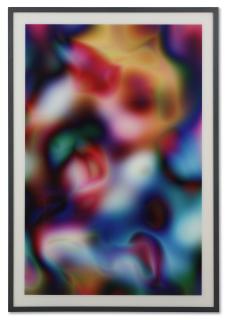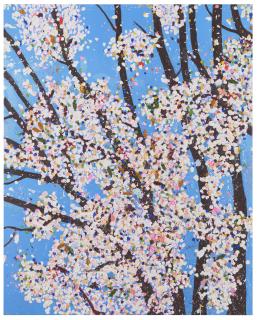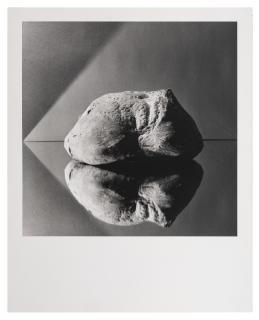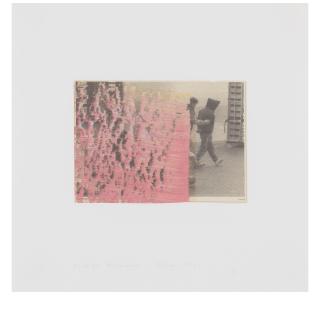Hiroshi Sugimoto born 1948 in Tokyo
The artist Hiroshi Sugimoto
- Japanese conceptual photographer who exclusively takes black-and-white photographs.
- His works appear in series; they follow surrealist and dadaist visual aesthetics.
- Lives and works in New York and Tokyo.
Hiroshi Sugimoto, born 23.02.1948 in Tokyo, is a Japanese conceptual photographer known for his artistic light-and-shadow stagings. Sugimoto exclusively produces black-and-white photographs in thematic series – in his work series he has already turned to the themes of diorama (Dioramas from 1974), wax figures (Wax Museums from 1976), theatre and cinema (Theaters from 1978), seascapes (Seascapes from 1980) and architecture (Architecture from 1997). His intention is to explore human ideas of conservation and memory.
His pictorial aesthetics are oriented towards Surrealism and Dadaism and are achieved through extremely long exposure times. The light, which in this way presents itself unnaturally, conveys a ghostly atmosphere in keeping with the idea of the visualisation of transience. Sugimoto studied political science and sociology at Saint Paul's University in Tokyo.
After graduating in 1970, he moved to Los Angeles. There he studied photography at the Art Center College of Design. During this time, he was already influenced by US Minimalism and Conceptual Art. In 1974, he moved to New York, where he still lives and works, alternating with Tokyo. Sugimoto has been honoured with various awards, including the Hasselblad Foundation International Award in Photography (2001), the German Photography Book Prize (2006/2007) and the Praemium Imperiale (2009).
In 2005 and 2006, his works were shown in a retrospective first at the Mori Art Museum in Tokyo and then at the Hirshhorn Museum and Sculpture Garden in Washington D.C. and the Modern Art Museum of Fort Worth (Texas). Sugimoto's works are sometimes included in the collection of the Guggenheim Museum in New York.
Der Künstler Hiroshi Sugimoto
- Japanischer Konzeptfotograf, der ausschließlich Schwarzweißfotografien fertigt.
- Fertigt thematische Werkreihen; sie folgen surrealistischer und dadaistischer Bildästhetik.
- Lebt und arbeitet in New York und Tokio.
Hiroshi Sugimoto, geb. 23.02.1948 in Tokio, ist ein japanischer Konzeptfotograf, der für seine kunstvollen Licht-und-Schatten-Inszenierungen bekannt ist. Sugimoto fertigt ausschließlich Schwarzweißfotografien in thematischen Serien – so wandte er sich in seinen Werkreihen bereits den Themen Diorama (Dioramas ab 1974), Wachsfiguren (Wax Museums ab 1976), Theater und Kino (Theaters ab 1978), Meeresansichten (Seascapes ab 1980) und Architektur (Architecture ab 1997) zu.
Seine Intention ist es, die menschlichen Ideen von Konservierung und Erinnerung zu ergründen. Seine Bildästhetik orientiert sich am Surrealismus und Dadaismus und wird durch extrem lange Belichtungszeiten erzielt. Das sich auf diese Weise unnatürlich darbietende Licht übermittelt passend zur Idee der Vergegenwärtigung von Vergänglichkeit eine gespenstische Atmosphäre. Sugimoto studierte Politikwissenschaft und Soziologie an der Saint Paul’s University in Tokio.
Nach seinem Abschluss 1970 zog er nach Los Angeles. Dort schloss er ein Studium der Fotografie am Art Center College of Design an. Bereits während dieser Zeit ließ er sich vom US-amerikanischen Minimalismus und der Konzeptkunst beeinflussen. 1974 ging er nach New York, wo er noch heute im Wechsel mit Tokio lebt und arbeitet. Sugimoto wurde mit verschiedenen Auszeichnungen geehrt – dazu gehören u. a. der Hasselblad Foundation International Award in Photography (2001), der Deutsche Fotobuchpreis (2006/2007) sowie der Praemium Imperiale (2009).
2005 und 2006 waren seine Werke im Rahmen einer Retrospektive zuerst im Mori-Kunstmuseum in Tokio und anschließend im Hirshhorn Museum and Sculpture Garden in Washington D.C. sowie im Modern Art Museum of Fort Worth (Texas) zu sehen. Sugimotos Arbeiten sind mitunter in der Sammlung des Guggenheim Museum in New York vertreten.
Hiroshi Sugimoto in a nutshell
In the early 1970s, Sugimoto moved to Pasadena, California, to study at the Art Center College of Design. He graduated with a bachelor's degree in 1974 and moved to New York City. There, he also traded in Japanese antiques for a living.
One of the defining features of Hiroshi Sugimoto's art is his exploration of time and its impact on our perception of the world. Through his long-exposure photographs, Sugimoto creates images that condense hours, days, or even years into a single frame. By capturing the passage of time in a single image, he invites viewers to contemplate the transience and impermanence of existence. Sugimoto's photographs often depict subjects such as seascapes, movie theaters, and architectural structures, where the passage of time becomes tangible, blurring the boundaries between past, present, and future.
Sugimoto's work is characterized by a minimalist aesthetic, where simplicity and clarity reign. He often strips his photographs of extraneous details, focusing on essential elements and reducing the image to its purest form. This minimalist approach creates a sense of serenity and stillness, allowing viewers to immerse themselves in the contemplative atmosphere of his images. Sugimoto's careful composition and use of negative space evoke a sense of tranquility, encouraging introspection and a meditative state of mind.
Light and shadow play a crucial role in Sugimoto's photographs, adding depth, texture, and mood to his images. Whether it's the soft glow of sunlight on a seascape or the dramatic interplay of light and darkness in his architectural studies, Sugimoto skillfully captures the nuances of illumination. The contrast between light and shadow enhances the visual impact of his photographs, creating a captivating interplay that draws viewers into the image and invites them to explore its intricacies.
Hiroshi Sugimoto's art pushes the boundaries of traditional photography, blurring the line between it and other artistic mediums. His use of large-format cameras and meticulous darkroom techniques harks back to early photographic processes, lending his work a sense of timelessness and craftsmanship. By presenting familiar subjects in a new light, Sugimoto challenges our preconceived notions and expands our understanding of the world.
Hiroshi Sugimoto's art has had a profound impact on the world of photography. His unique approach, blending technical precision, minimalist aesthetics, and philosophical inquiry, has inspired countless photographers and artists. His work has been exhibited in prestigious galleries and museums worldwide, earning him critical acclaim and a dedicated following of admirers.
Enoura Observatory is a complex of buildings in Odawara, a city near Tokyo. It was designed by Hiroshi Sugimoto and aims to educate everyone about Japanese art, culture and architecture. From the observatory, you have a wonderful view over Sagami Bay towards the east. A highlight is watching the sunrise over the Pacific Ocean and how the traditional and modern Japanese buildings are bathed in special light. More information is available here.
Most of the photographer's works range between $1,000 and $50,000, the usual range for photographs. Unlike most fine art photographers, Sugimoto's work has outliers on the upside. To date, more than 70 works have fetched over $50,000, with some even exceeding $500,000, which is very high for the medium and underscores Sugimoto's exceptional position. Sugimoto experienced his peak period at auction so far in 2007 and 2008.
Häufige Fragen zu Hiroshi Sugimoto
Anfang der 1970er zog Sugimoto nach Pasadena in Kalifornien, um am Art Center College of Design zu studieren. Er schloss das Studium 1974 mit einem Bachelor ab und zog nach New York City. Dort handelte er zum Lebensunterhalt auch mit japanischen Antiquitäten.
Eines der charakteristischen Merkmale von Hiroshi Sugimotos Kunst ist seine Auseinandersetzung mit der Zeit und ihrem Einfluss auf unsere Wahrnehmung der Welt. Mit seinen Langzeitbelichtungsaufnahmen schafft Sugimoto Bilder, die Stunden, Tage oder sogar Jahre in einem einzigen Bild zusammenfassen. Indem er den Lauf der Zeit in einem einzigen Bild festhält, lädt er den Betrachter ein, über die Vergänglichkeit und Unbeständigkeit der Existenz nachzudenken. Sugimotos Fotografien zeigen häufig Motive wie Meereslandschaften, Kinos und architektonische Strukturen, in denen der Lauf der Zeit greifbar wird und die Grenzen zwischen Vergangenheit, Gegenwart und Zukunft verschwimmen.
Sugimotos Werk zeichnet sich durch eine minimalistische Ästhetik aus, in der Einfachheit und Klarheit vorherrschen. Er befreit seine Fotografien oft von überflüssigen Details, konzentriert sich auf die wesentlichen Elemente und reduziert das Bild auf seine reinste Form. Diese minimalistische Herangehensweise schafft ein Gefühl der Ruhe und Stille, das es dem Betrachter ermöglicht, in die kontemplative Atmosphäre seiner Bilder einzutauchen. Sugimotos sorgfältige Komposition und die Verwendung des negativen Raums rufen ein Gefühl der Ruhe hervor, das zur Selbstbeobachtung und zu einem meditativen Geisteszustand anregt.
Hiroshi Sugimoto überschreitet mit seiner Kunst die Grenzen der traditionellen Fotografie und verwischt die Grenzen zwischen ihr und anderen künstlerischen Medien. Sein Einsatz von Großformatkameras und akribischen Dunkelkammertechniken geht auf frühe fotografische Verfahren zurück und verleiht seinen Arbeiten ein Gefühl von Zeitlosigkeit und Handwerkskunst. Indem er vertraute Motive in einem neuen Licht präsentiert, stellt Sugimoto unsere vorgefassten Meinungen in Frage und erweitert unser Verständnis der Welt.
Hiroshi Sugimotos Kunst hat die Welt der Fotografie tiefgreifend beeinflusst. Sein einzigartiger Ansatz, der technische Präzision, minimalistische Ästhetik und philosophische Fragen miteinander verbindet, hat unzählige Fotografen und Künstler inspiriert. Seine Werke wurden weltweit in renommierten Galerien und Museen ausgestellt und haben ihm viel Lob von Kritikern und eine treue Fangemeinde eingebracht.
Das Enoura Observatory ist ein Gebäudekomplex in Odawara, einer Stadt in der Nähe von Tokio. Er wurde von Hiroshi Sugimoto entworfen und hat zum Ziel, allen Menschen die japanische Kunst, Kultur und Architektur zu vermitteln. Vom Observatorium aus hat man einen wunderbaren Blick über die Sagami-Bucht Richtung Osten. Ein Highlight ist das Beobachten des Sonnenaufgangs über dem Pazifik und wie die traditionellen und modernen japanischen Gebäude in besonderes Licht getaucht werden. Mehr Informationen gibt es hier.
Die meisten Arbeiten des Fotografen bewegen sich in der Spanne zwischen 1.000 und 50.000 US-Dollar, also in dem für Fotografien üblichen Bereich. Anders als bei den meisten Kunstfotografen gibt es bei Sugimoto Ausreißer nach oben. Bisher erzielten über 70 Arbeiten einen Preis über 50.000 US-Dollar, einige sogar mehr als 500.000. Das ist sehr hoch für dieses Medium und unterstreicht Sugimotos Ausnahmeposition. Seine bisherige Hochphase bei Auktionen erlebte Sugimoto in den Jahren 2007 und 2008.

